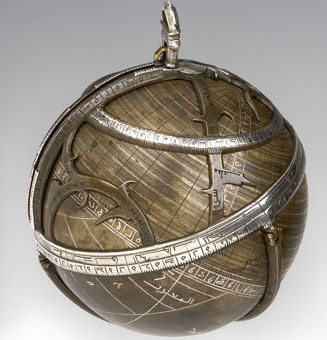
| Date | 1480/1 (A. H. 885) |
| Maker | Mūsa |
| Place | Syria (?) |
| Material | Brass |
| Inventory no. | 49687 |
| Acquisition | Purchased at Sotheby's, London, in 1962 |
Manuscript descriptions of the spherical astrolabe exist, in Arabic, Latin, and even Catalan; and other medieval records imply that they did exist among the possessions of mathematicians. But in modern times no example was known until 1962, when an object offered for sale through Sotheby's was identified by the curator of the Museum of the History of Science, Francis Maddison, as a spherical astrolabe. It remains the only complete spherical astrolabe known to be extant.
In spite of its being signed and dated, little can be said of its origins. Unusually for an Arab the maker signs with a single name, Mūsa (the Arabic equivalent of Moses, and quite a common name). He is known only from this one instrument. The date of A.H. 885 also tells us little. It is over two centuries after the classic treatises on the instrument were written, and rather late in the period to which the style of workmanship belongs.
The general style, and in particular the use of Kufic lettering and damascened lettering and decoration, place it in the Syro-Egyptian region, where the centres of craftsmanship were Cairo and Damascus. The silver damascening clearly signals it as a skilfully made and very costly object.
View all
images for this astrolabe
View
detailed provenance for this astrolabe